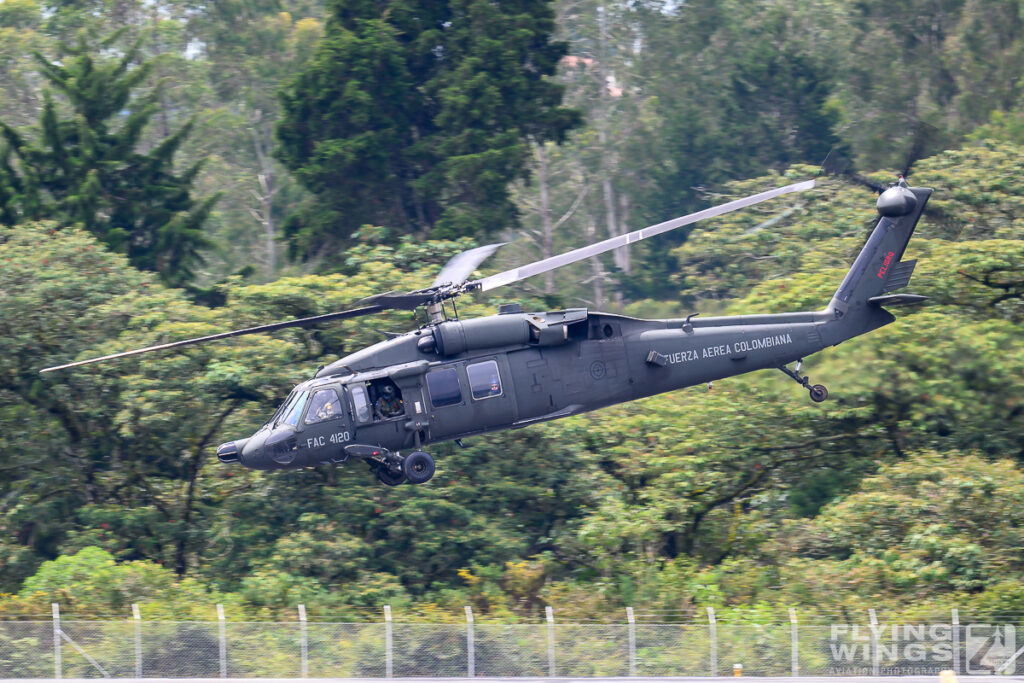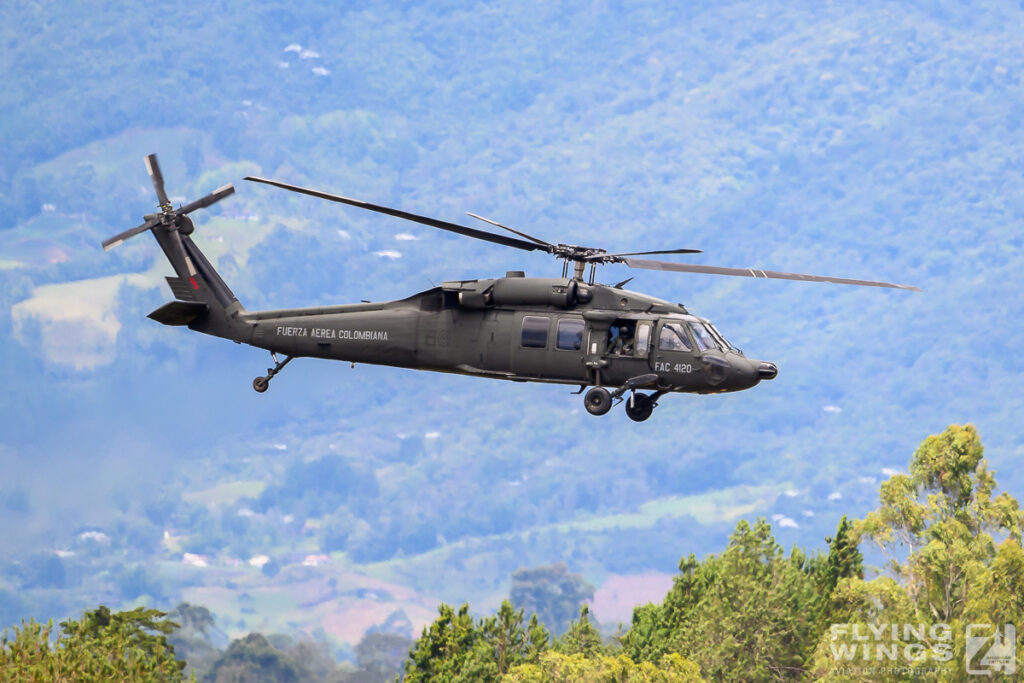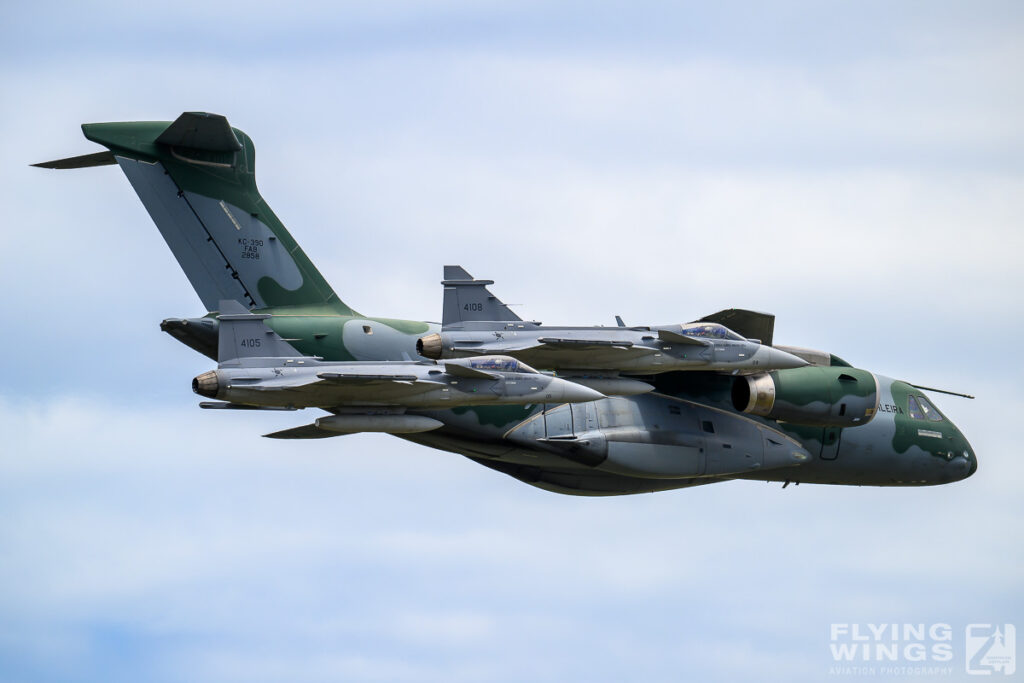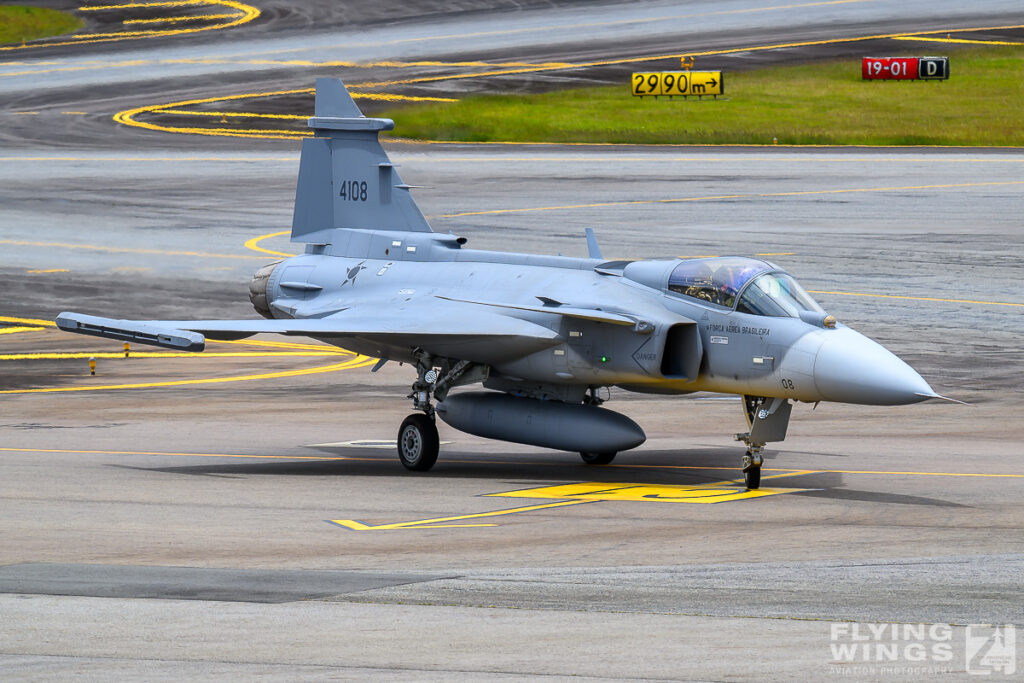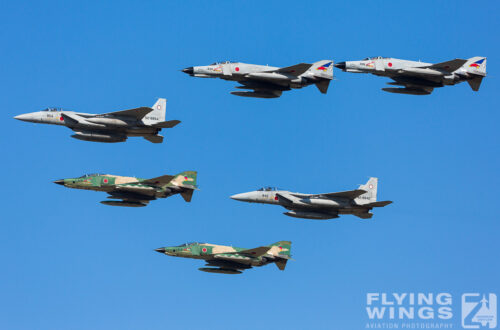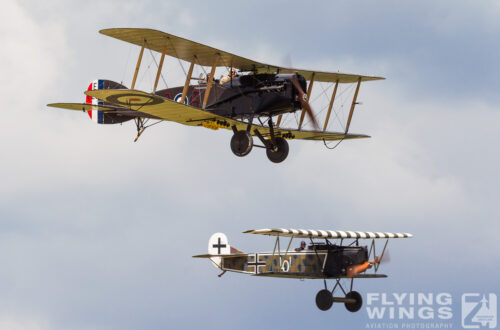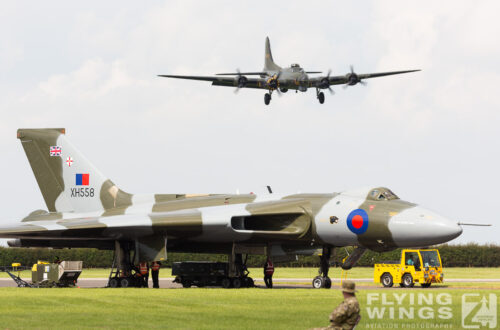
F-Air Colombia 2025 – Roaring Kfirs over the Andes
High above the verdant valleys of Antioquia, the thunder of jet engines once again echoed through the skies over José María Córdova International Airport as F-Air Colombia 2025 opened its gates. Held from July 9–14 in Rionegro—just a short drive from the vibrant city of Medellín—this biennial airshow and trade fair has grown into South America’s foremost gathering for military delegations, manufacturers, and aviation enthusiasts. While its roots remain firmly planted in Colombia’s domestic aerospace and defense industries, the event increasingly draws regional attention, showcasing the operational strength and future ambitions of the Fuerza Aeroespacial Colombiana (FAC).
Colombia’s Proud Showcase
F-Air’s public days—from Friday to Sunday—once again burst at the seams. Tens of thousands of spectators, including expatriate Colombians from across the United States and Europe, poured through the gates to witness the only public aerial demonstrations by Colombia’s armed forces. For many, it is the sole opportunity to see FAC fast jets, helicopters, and special-operations platforms in action outside classified operations. More than mere spectacle, the airshow has become both a symbol of national pride and a barometer of regional defense diplomacy.

Colombian President Gustavo Petro’s appearance at the opening ceremony lent further significance to the event. Standing beneath the silhouette of a Kfir jet, Petro lauded the military’s dual role in safeguarding sovereignty and delivering humanitarian aid. He declared:
“Our military aviation is not only a shield of sovereignty, it is the wing of the Republic that reaches where roads do not, rescues where others cannot, and protects the skies of our freedom.”

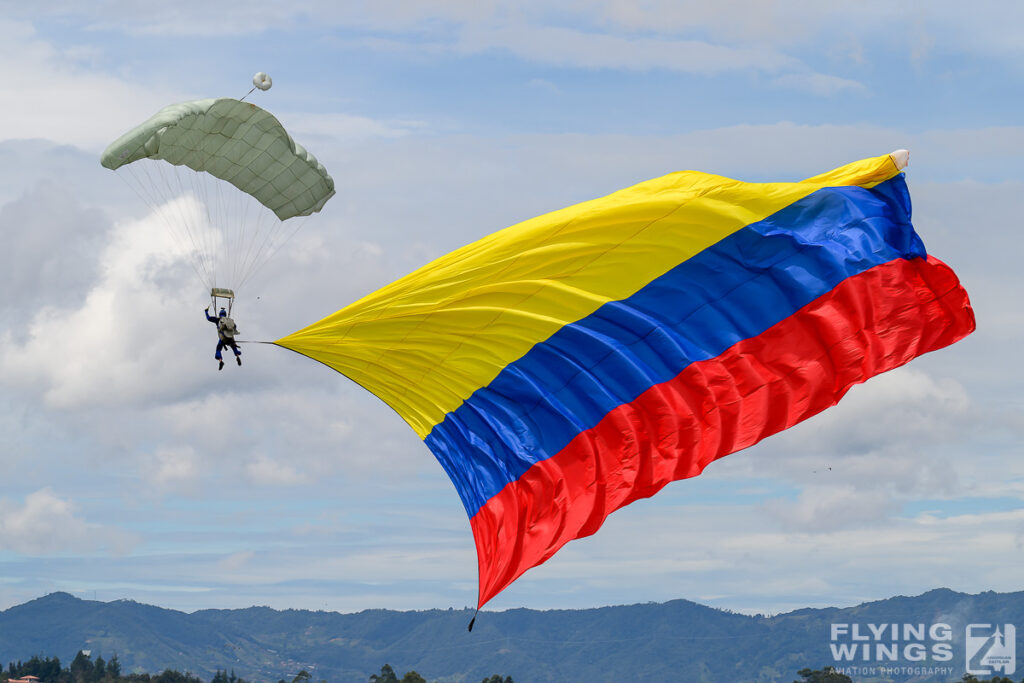
His comments underscored the country’s reliance on airpower to combat organized crime, support disaster response, and secure remote communities—missions that often demand unique platforms and innovative tactics.
A Diplomatic High Point
Amid Colombia’s internal debates over modernization budgets and fleet replacements, the presence of Sweden’s Minister for Defence, Pål Jonson, marked one of F-Air 2025’s most diplomatically charged moments. Flanked by Saab executives, Jonson championed the JAS 39E/F Super Gripen as the successor to Colombia’s aging fleet of Kfir fighters—aircraft that have served the nation for over four decades. While rumors swirled that a deal was “all but finalized,” Saab’s representatives emphasized partnership, regional industrial offsets, and technology transfer as keystones of their offer.
Jonson’s subsequent flight to Lima to press the same case for Peru’s Air Force highlighted Saab’s broader Latin American campaign. For Colombia, the choice carries strategic weight: the Kfir, though venerable, faces obsolescence and shrinking numbers of airworthy examples. The Super Gripen would bring network-centric capabilities, advanced sensors, and lower lifecycle costs—a blend seemingly aligned with President Petro’s vision of an air force “capable, sovereign, and regionally integrated.”
From Fast Jets to Firefighters
F-Air’s opening flying display on Wednesday was deliberately modest—yet it offered a visceral statement. Two Palanquero-based Kfirs screamed low and fast over the crowd, a reminder that these delta-winged fighters still form Colombia’s only supersonic interception screen. The main act, however, came from Brazil’s Força Aérea Brasileira: the “Millennium Formation” of an Embraer KC-390 flanked by two F-39E Gripens. Their precision passes underscored not only regional camaraderie but also the commercial ambitions of Embraer and Saab to fill gaps in Colombia’s transport and fighter inventories.
As public days dawned on the weekend, the full spectrum of FAC operations took flight:
Dardos Kfir Display
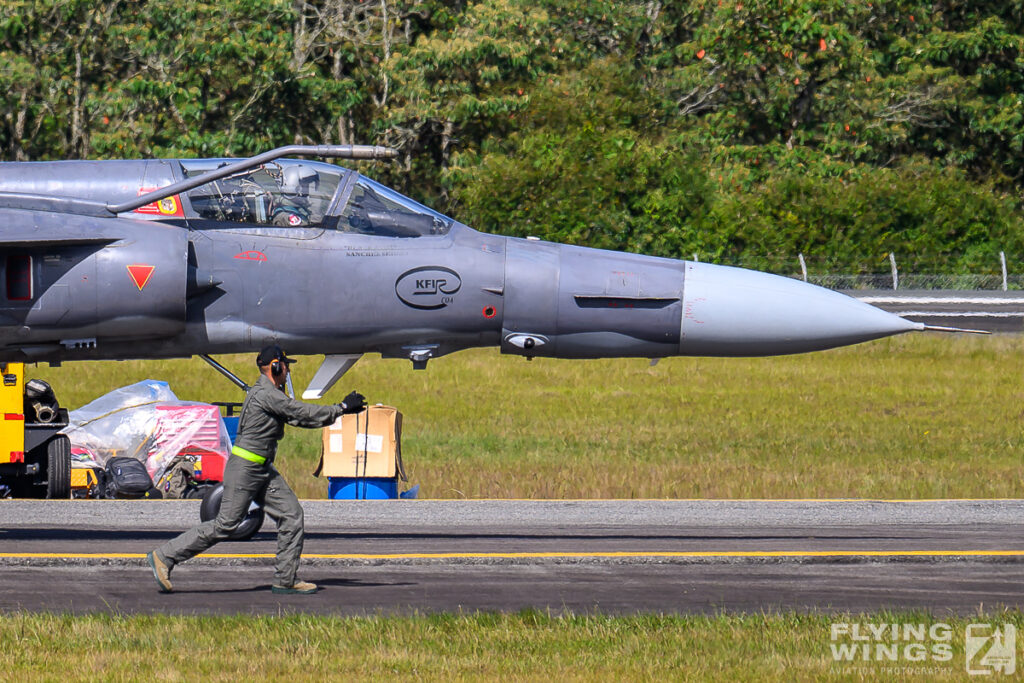
Colombia’s elite Kfir team, “Dardos,” delivered a two-ship precision routine, complete with live narration, a military band playing from the ramp, and fully integrated ground-crew choreography. Their dramatic break maneuvers, formation loops, and tactical passes culminated in both jets taxiing to the crowd line, engines idling to thunderous applause. With Kfir numbers dwindling, the performance felt part demonstration, part farewell ceremony.

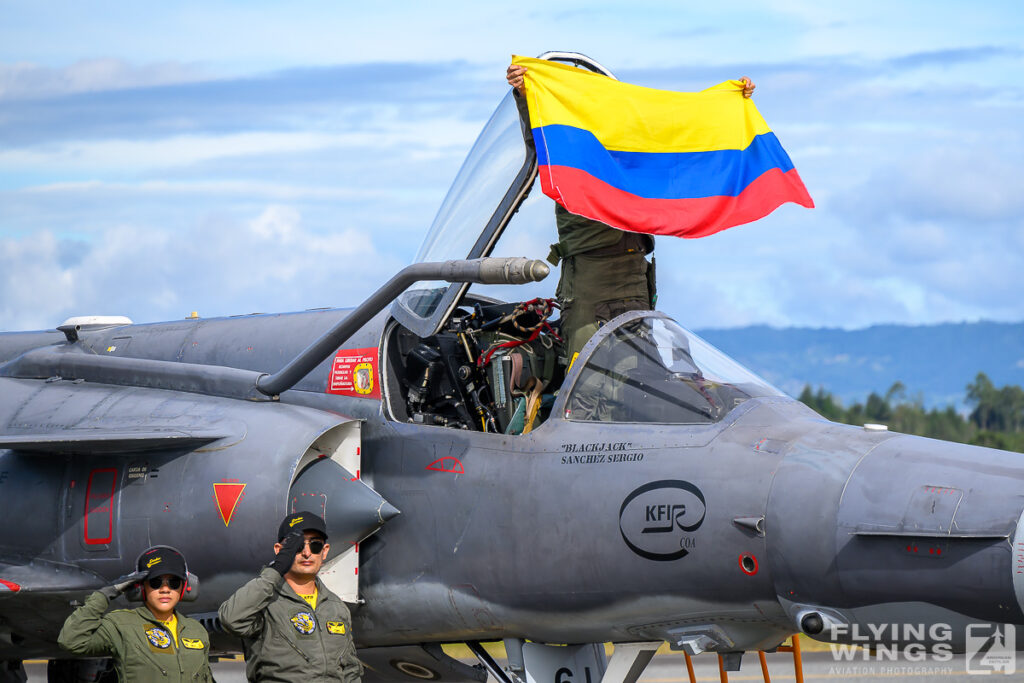
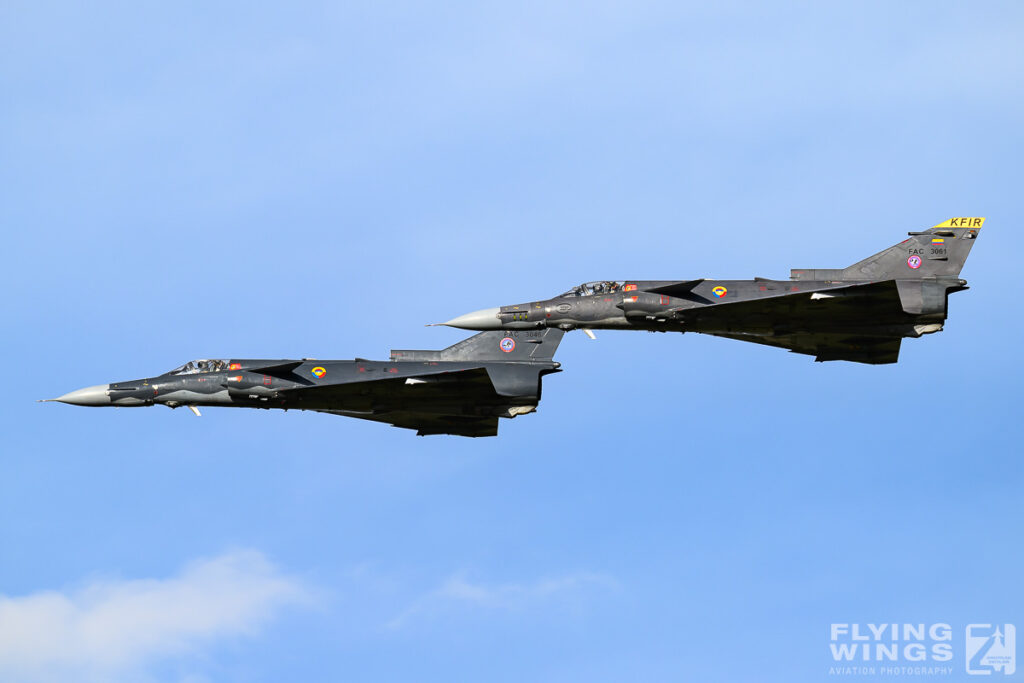
Arpía 51 Helicopter Ballet

In stark contrast, the AH-60L Arpía gunships of FAC special operations wing performed an aerial ballet—hovering pirouettes, cross-deck passes, and vertical climbs punctuated by flare releases. Modified in-country by Elbit Systems, these Black Hawks exemplify Colombia’s counterinsurgency and anti-narcotics doctrine: agile, heavily armed, and capable of jungle insertions at treetop level.
T-6C Texan II Formation


A five-ship Beechcraft T-6C Texan II formation offered an elegant but potent display. Splitting into a solo element and a rotating four-ship group, the Texan routine highlighted the trainer’s dual role in pilot development and light-attack reconnaissance—essential missions across Colombia’s mountainous and forested terrain.
“Tifón” Firefighting Hercules

On Saturday, the FAC’s uniquely modified C-130H Hercules—callsign 1005, nicknamed “Tifón”—made a dramatic low-level pass, deploying thousands of liters of water in seconds via bespoke, side-mounted pipes. A choreographed commentary explained the aircraft’s vital role in wildfire suppression across Colombia’s páramos and forested regions, as well as its Antarctic supply missions, denoted by distinctive snowy runway insignias.
Special Operations Set-Piece



The final aerial act merged a UH-60 Black Hawk and a CASA C-295 in a simulated infiltration. Parachutists, ground pyrotechnics, and a hot-refueling demonstration—where the helicopter received fuel from the transport’s tanks while both aircraft ran—underscored the FAC’s expeditionary capabilities in austere environments.
Ground Power and National Defence Presence
The static park offered an up-close view of Colombia’s operational fleet. On the rotary-wing ramp, a UH-60L Black Hawk in full combat configuration, an AH-60L Arpía, and a venerable Bell UH-1D Huey II lined up to illustrate doctrinal evolution from legacy support to modern gunship roles. On the fixed-wing side, visitors inspected a two-seat Kfir TC-12, a T-6C Texan II in clean configuration, an A-29B Super Tucano from COIN wings, and a Cessna 208 Caravan outfitted for ISR missions in remote areas.

Colombia’s National Police Aviation Group added its own flavor: a Bell 206 JetRanger, a modified Cessna light aircraft, a surveillance-configured Caravan, and notably an Air Tractor AT-802—an agricultural airframe repurposed for coca eradication under counter-narcotics missions. Adapted with sensors and spray booms, the AT-802 embodies the police’s clandestine air campaigns and underscores Colombia’s integrated approach to internal security.
International Flavors
While Colombia dominated the ramp and sky, a handful of foreign forces added context:
USAF F-16 Viper Demo
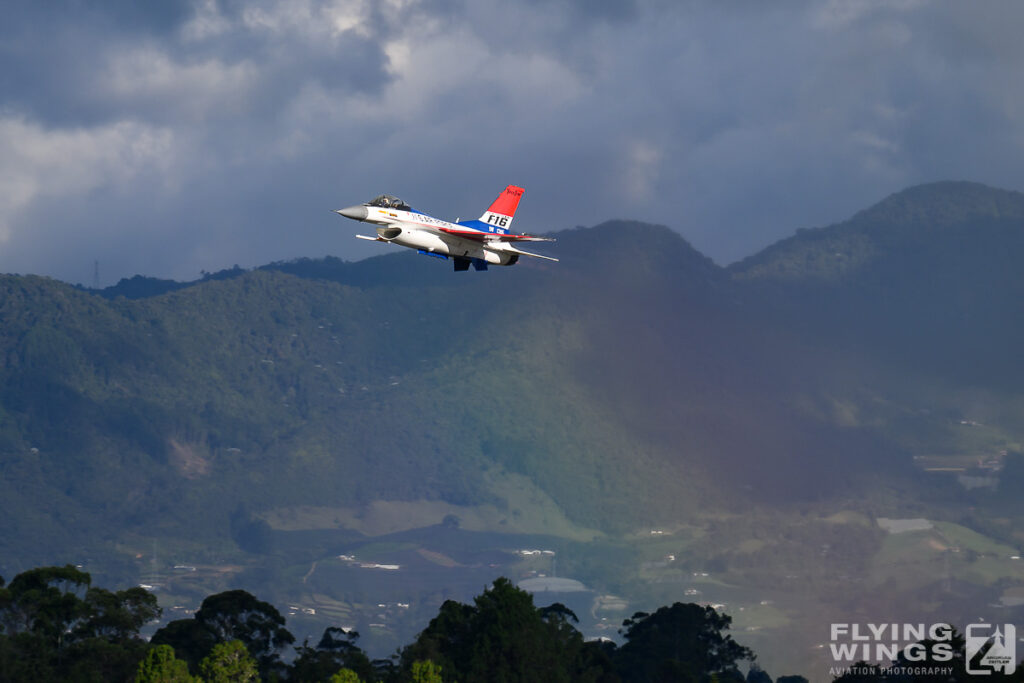
Maj. Taylor “FEMA” Hiester piloted the red-white-and-blue F-16C, executing high-G turns, high-alpha passes, and vertical climbs that thrilled the crowd. A second F-16 and a C-130J Hercules on static highlighted ongoing U.S.–Colombian cooperation in counter-narcotics, intelligence sharing, and airlift training.
Brazilian Gripen and KC-390


Beyond the Mllennium flypast in formation with two Gripen E, Brazilian ground crews offered guided tours of the KC-390 and F-39E Gripens, directly engaging FAC logisticians on payload, cockpit modernity, and altitude performance—critical for high-mountain operations.
Dominican TP-75

A lone Italian-built TP-75 trainer/patrol aircraft from the Dominican Republic rounded out the show. This ultralight turboprop, resembling a mini-Super Tucano, showcased how smaller air forces leverage cost-effective airframes for training and surveillance.
Crossroads and Contrails – The Future
If any platform encapsulated the crossroads facing Colombian airpower, it was the Kfir. First delivered in the late 1980s and upgraded in the 2010s, these delta-winged fighters have outlasted peers worldwide—yet fatigue and parts scarcity now limit active numbers to the single digits. Discussions with FAC officers confirmed that while Gripen negotiations are “at an advanced stage,” no contract has been inked. As one senior officer noted off-record, “It’s not just about jets; it’s about training, infrastructure, system integration, and long-term industrial offsets.”

With Summer 2025 marking possibly the Kfir’s twilight, Colombia’s rotary-wing fleet continues to expand special operations, search-and-rescue, and anti-narcotics endurance missions. And on the transport front, Embraer’s KC-390 looms large as the C-130B/H successor, promising improved runway performance and lower operating costs. The FAC’s ability to adapt—slowly but deliberately—to evolving doctrines remains its greatest asset.
The photographer’s perspective
For aviation photographers, F-AIR 2025 required a bit of strategy. Arriving early was essential for anyone hoping to get clean shots of the static display, since many aircraft were either tightly fenced off or packed so closely together that compositions became tricky. A few airframes were displayed without barriers, but those quickly disappeared behind crowds as the day went on. The flying display offered better conditions, and decent photos were possible from the regular showground, though spectators shouldn’t expect a front-row position and must contend with the civil terminal partially blocking approaches from the right.


The grandstand, while densely packed and enforcing a no-standing rule, proved to be the best option: aircraft were parked directly in front of it, and the elevated view delivered unobstructed lines of sight across the runway and taxiways. It’s also worth noting that all commercial operations at José María Córdova Airport were paused during the flying segments, an impressive logistical feat for a busy international hub. As Rionegro continues to grow, this arrangement may become harder to sustain, which could eventually force changes to how extensive future flying programs can be.
Conclusion of F-Air 2025 at Rionegro / Medellin

F-Air 2025 underscored Colombia’s strategic balancing act between legacy platforms and next-generation systems, all set against the region’s most spectacular showground. Rionegro’s high-altitude runway, framed by the lush Andes, provided dramatic photo conditions and a refreshing climate—proof that the setting is as compelling as the flying. And beyond the airshow’s fences, Colombia beckons travelers with world-class hospitality, rich cultural heritage, and natural wonders from Coffee Triangle landscapes to Caribbean beaches.



In the end, F-Air remains more than an airshow: it is a celebration of Colombia’s resilience, innovation, and the indomitable spirit of its airmen and women. Whether you come for the roar of the Kfir, the ballet of the Arpías, or simply the thrill of discovery, Rionegro and Colombia stand ready to welcome you.
F-Air 2025 at Rionegro / Medellin – Photo Gallery


